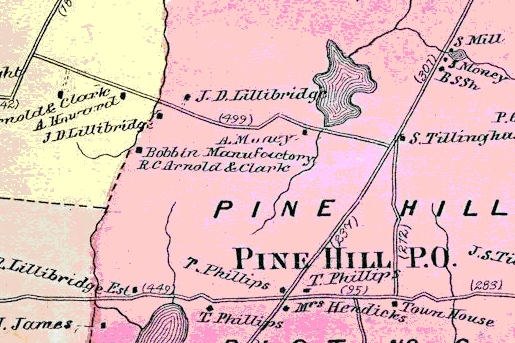[This post originally appeared in the July 2021 edition of The Hinterlander, the monthly newsletter of the Western Rhode Island Civic Historical Society]
This is the last in a series of articles on Exeter for The Hinterlander written in connection with the “Lost Mill Towns” project, an effort to identify and describe the so-called “mill towns” that once dotted the western Rhode Island countryside. In May, the focus was on Exeter’s Dorset Mills, in the southeast corner of town proximate to North Kingstown and the Providence & Stonington Railroad. Last month the Exeter mill town project went on hiatus for a brief look at the history of Fathers Day. This month’s article will conclude this series on Exeter with a review of the manufacturers adjacent to and nearby the New London Turnpike in the Pine Hill region of town, and of the sawmills that were once located in Exeter’s northeastern corner.
The Providence & Pawcatuck Turnpike Company began building what would become known as the New London Turnpike in 1816, and was responsible for building the section of the road from West Warwick to the village of Wyoming in Richmond. However, though this may have been the fastest and most direct route to connect Providence, Rhode Island to New London, Connecticut, it did not intersect with most of Exeter’s waterways, and few of Exeter’s manufactories were located along or near to the turnpike.
However, one such factory was located on the turnpike right on the border with West Greenwich just over the line in Exeter, not far from Spencer’s Four Corners. James Stevens’s 1831 map of Rhode Island identifies the site as Congdon Hopkins Factory. What was manufactured there is something of a mystery – Cole’s History of Washington and Kent Counties makes no mention of the business, nor does the RI Island Historical Preservation & Heritage Commission’s 1976 survey of historic sites in Exeter. The factory only appears on the 1831 Stevens map; a map drawn by civil engineer Henry Walling in 1855 makes no note of it, nor does Beers in 1870 or Everts & Richards in 1895.
 |
Excerpt from James Stevens 1831 map, noting the location of the Congdon Hopkins Factory. |
Nonetheless, using the Stevens map as a guide, the stone foundation of a modest factory building can still be found near a country path behind a bar-way about 20 yards from the road on the west side of the New London Turnpike -- see map (above) and video (below). The best time of year to view the ruins are in the winter and spring, as the foundation is surrounded by dense brush and brambles in the summer and fall.
What powered the mill is also something of a mystery. The only stream in this section of Exeter lies significantly to the west of the site, and there are no dams or ponds in the immediate vicinity of the foundation on the Stevens map. Perhaps the factory relied on steam power, though due to the cost of hauling coal overland to this site by ox and wagon suggests that, if anything, the preferred source of fuel was likely wood. The factory also exists in isolation; there are no mill houses or foundations in the vicinity of the present mill site or found on the map. However, given its location right on the New London Turnpike, it could be assumed that workers walked to the mill via the pike from nearby West Greenwich or from locations south of the factory in Exeter.
It is also not possible to state with any certainty if the Congdon Hopkins Factory had two owners – Congdon and Hopkins, or if it was a sole proprietorship under the ownership of one Congdon Hopkins. According to South County naming conventions in the eighteenth and nineteenth centuries, parents often named their sons after a respected local family. The only further source of information about this factory beyond the map (or an archaeological survey of the site itself) may the Exeter Town Hall. If property tax or assessment records for the 1820s and 1830s still exist, then more may be said about this mill site.
South of the Congdon Hopkins Factory along east side of the New London Turnpike is Money Swamp Pond, probably named for one S. Money, whose name is affixed to a building just south of the pond on the 1870 Beers map. The pond was created by damming the branch of the Congdon River that crosses the turnpike. There, a sawmill was built, and along the pike to this day the dam and a rather substantial foundations of the mill, along with a nearby house and barn are still extant. On the 1895 Everts & Richards map the saw mill site is labeled as “Work In.”
 |
| Photo taken by author |
North and west of the intersection of New London Turnpike and Ten Rod Road south of Congdon Mill Road on the 1870 Beers map was the Bobbin Manufactory of R.C. Arnold & Clarke. This factory was located on a stream west of Millbrook Pond and the Lillibridge Burial Ground, east of the elementary school and Exeter-West Greenwich Regional High School. This area of Exeter is fairly desolate today; it is not possible to reconnoiter the area without trespassing onto private property to see what might possibly remain of this bobbin factory.
 |
Beers 1870 map of the Pine Hill area of Exeter, locating the Arnold & Clarke Bobbin Factory and Money Pond Sawmill. |
One common characteristic to note -- all the manufactories in the Pine Hill area of Exeter have a distinct lack of mill villages. No mill houses, no stores or gristmills. Only the Money Swamp Pond saw mill had any contemporaneous buildings in its vicinity.
Finally, there were two saw mills labeled on the 1870 Beers map to the east of R.C. Reynold & Clarke’s bobbin factory. Both of these were built on the westernmost section of Stony Lane, on the section of this road that remains unpaved to this day. Both were to the north of Lawtonville, Hallville, Fisherville and Exeter Hollow. The most easterly of these, the Rodney Lewis sawmill, was powered by a small pond that was created by damming Queen River. Today the roadway that leads to the site is a private drive and it is posted. The second sawmill, due west of the first, was built along a small stream that crossed Stony Lane next to the property of one S.S. Rose, according the 1870 Beers map. Currently the section of Stony Lane on which the “Rose” sawmill was located, is closed to public access from both ends. The road is licensed to one American Tower, a real estate investment trust headquartered in Boston, Massachusetts that owns and operates wireless and broadcast communications infrastructure at hundreds of thousands of sites across the United States and internationally. Very likely, on or near the site of the Rose sawmill there is a cell phone tower today.
This ends our review at the factories and mill towns of Exeter Rhode Island. Though far more industrialized than West Greenwich to the north, the town Exeter remained entirely rural, never developing central business districts similar to those found in neighboring North and South Kingstown. Nor did her mill towns ever grow to the size and scope of those found to south, in the town of Richmond. While Rhode Island’s textile business began to go into decline in the 1920s, Exeter’s mills began closing down in the 1870s. And with the exception of Lawton’s Mill on Route 102 and Dorset Mill on Yorker Pond, Exeter’s mill buildings are no longer extant. But the foundations and ruins of the town’s gristmills, sawmills and textile factories speak to that time when manufactories did their business along the streams in the rural countryside, cheek to jowl with the town’s woodsmen and farmers.
_______________________________________________________
Bibliography
American Tower Corporation, “Global Leader in Wireless Infrastructure.” Company, ATC IP LLC, 2021.
Atlas of
Atlas of the State of
1870.
Cole, J. R., History of
1889.
Commission,
Stevens, James, “A topographical map of the state of Rhode-Island and Providence Plantations,
surveyed trigonometrically and in detail by James Stevens, topographer and civil engineer,
Tiner Jason, "
University Fall 2001 (retrieved from the Internet Archive Wayback Machine).
Walling, Henry Francis, “Map of the
State of
from surveys" L.H. Bradford & Co.'s
Lith.,




No comments:
Post a Comment